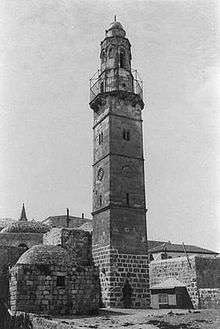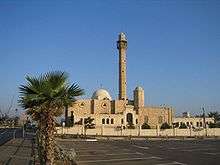Al-Khanqah al-Salahiyya Mosque
The al-Khanqah al-Salahiyya Mosque (Arabic: مسجد الخانقاه الصلاحية) is located in the Christian Quarter of the Old City of Jerusalem, north of the Church of the Holy Sepulchre.
| Al-Khanqah al-Salahiyya Mosque مسجد الخانقاه الصلاحية | |
|---|---|
 Ottoman period | |
| Religion | |
| Affiliation | Islam |
| District | Jerusalem |
| Location | |
| Location | Christian Quarter, Old City, Jerusalem |
| Architecture | |
| Type | Mosque |
| Style | Ayyubid, Ottoman |
| Minaret(s) | 1 |
History
The mosque is situated on the former palace of the Latin Patriarch. Following the Crusader surrender of Jerusalem to Salah ad-Din (Saladin) in 1187 (i.e. 'al-Salahiyya'), it became a mosque. Its minaret was built in 1417.[1][2]
The two mosques flanking the Holy Sepulchre
The Mosque of Omar, located on the other side of the Church of the Holy Sepulchre, has an almost identical minaret.[3] The two minarets were obviously designed as a pair; a line connecting the two minarets would intersect the door of the Tomb of Jesus inside the church, and the minarets are equidistant to that door[3] with their tops at exactly the same elevation despite starting at different ground levels.[4] Murphy-O'Connor suggests that the Mamluk rulers may have had the intention "to 'nullify' the Holy Sepulchre", since in Islam the belief is of Allah physically raising Jesus into heaven, while it does not support the notion of his crucifixion and death.[4]
Gallery
References
- Winter, Dave & Matthews, John. Israel Handbook, p. 147. Footprint Travel Guides, 1999. ISBN 1-900949-48-2
- Moudjir ed-dyn, 1876, p. 169
- El Khanqah-Moschee in Jerusalem (German text and pictures at theologische-links.de)
- Murphy-O’Connor, J. (2008). The Holy Land: An Oxford Archaeological Guide from Earliest Times to 1700. Oxford Archaeological Guides. Oxford: Oxford University Press. p. 62. ISBN 978-0-19-923666-4. Retrieved 20 June 2016.
Bibliography
- Berchem, van, M. (1922). MIFAO 43 Matériaux pour un Corpus Inscriptionum Arabicarum Part 2 Syrie du Sud T.1 Jérusalem "Ville" (in French and Arabic). Cairo: Impr. de l'Institut français d'archéologie orientale. (pp. 87−91)
- Burgoyne, Michael Hamilton (1987). Mamluk Jerusalem. ISBN 090503533X. (pp. 517−518)
- Moudjir ed-dyn (1876). Sauvaire (ed.). Histoire de Jérusalem et d'Hébron depuis Abraham jusqu'à la fin du XVe siècle de J.-C. : fragments de la Chronique de Moudjir-ed-dyn.





